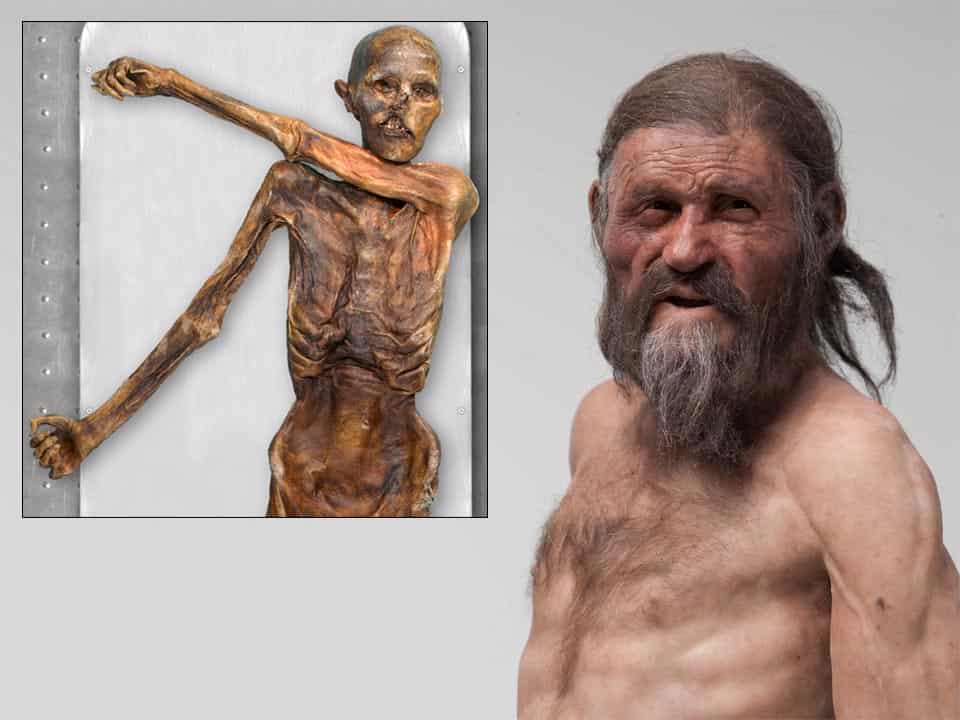
Researchers have once again delved deep into the genome of Ötzi, the famous ancient glacier mummy, yielding remarkable insight into his ancestry and physical traits.
For instance, the scientists learned that Ötzi shares an unusually high number of genes with early Anatolian farmers when compared to his contemporaries. This discovery about Ötzi, an ancient iceman found preserved in the Alps, is significant as this could mean there was a genetic exchange between populations in the Mediterranean and those living in the Alps during that time.
Furthermore, the revelation of Ötzi’s darker skin challenges previous assumptions about his appearance. He was typically depicted as having lighter or pale skin in documentaries and other media. However, the new analysis indicates that his skin tone was closer to that of people with Mediterranean-European ancestry.
This information adds to our understanding of human migration and genetic diversity during the Copper Age, around 5,300 years ago when Ötzi lived. It highlights the interconnectedness of different ancient populations and breaks stereotypes and preconceived notions about historical individuals.
Finally, genome sequencing also changes previous assumptions concerning Iceman’s hair. Although popular depictions often showed him with a full head of hair, genetic data suggests he likely suffered from male-pattern hair loss, likely being bald at the time of his death.
Unveiling Ötzi’s Past
Ötzi, often referred to as the “Iceman,” was discovered in the Ötzal Alps in 1991. Through radiocarbon dating, scientists determined that he lived in the Italian part of the Alps approximately 3350–3210 years BCE. Scientists also determined that the man was shot by an arrow.
The discovery of the Iceman proved sensational at the time. Finally, Europeans had a glimpse of their ancestors — but their initial interpretations were likely very wrong.
More than a decade after Ötzi’s genome was first decoded, researchers from the Max Planck Institute for Evolutionary Anthropology and Eurac Research have harnessed advancements in sequencing technology to revisit his genome and enhance our understanding of this prehistoric individual. It’s the first time in ten years that a team of scientists has attempted to re-sequence the Iceman’s DNA.
But the process of sequencing Ötzi’s genome wasn’t without its challenges. Ancient DNA is typically degraded, making it difficult to piece together a complete genome. Moreover, the risk of contamination from modern DNA can skew results.
The last time Ötzi’s genome was sequenced in 2012, scientists led by Professor Andreas Keller from Germany found an intriguing connection to Steppe Herders. It marked the first time a mummy genome was sequenced. However, the data had limitations due to the technology available at the time and the small number of people who had had their genomes sequenced at that time to compare with Ötzi’s DNA.
Fast forward to the present, a team of researchers led by Professor Johannes Krause from the Max Planck Institute for Evolutionary Anthropology and colleagues armed themselves with a cutting-edge sequencing platform. Their mission: to achieve a higher coverage and accuracy of Ötzi’s DNA sequencing than ever before.
A Different Ancestral Tale
It worked. This new study not only corrected past inaccuracies but also uncovered unexpected findings. Contrary to previous conclusions, the new analysis found no evidence of Steppe-related ancestry in Ötzi’s genome — and this surprised everyone involved.
They attribute the earlier inaccuracies to contamination. In the current study, the high-coverage genome exhibited minimal contamination, providing more reliable data about Ötzi’s ancestry.
Comparing Ötzi’s genome to that of his contemporaries, scientists unveiled that his largest genetic contribution came from early Neolithic Anatolia farmers, with only a low proportion of hunter-gatherer genes in his genome and no Steppe Herder genetic markers to speak of.
This challenges previous assumptions, suggesting that Ötzi’s ancestors arrived directly from Anatolia without mixing with other European populations. This could be due to the remote Alps location, isolating these individuals genetically.
For comparison, the genetic makeup of contemporary Europeans is a blend of three ancestral groups: western hunter-gatherers, early Anatolian farmers, and Steppe Herders from Eastern Europe.
Beyond ancestry, the study provided insights into Ötzi’s appearance and health. His skin color was genetically determined to be much darker than previously thought — darker than modern South Europeans but lighter than modern Sub-Saharan Africans. The study also revealed a predisposition to male-pattern baldness, potentially explaining the mummy’s lack of hair.
“It’s the darkest skin tone that has been recorded in contemporary European individuals,” explains anthropologist Albert Zink, study co-author and head of the Eurac Research Institute for Mummy Studies in Bolzano.
“It was previously thought that the mummy’s skin had darkened during its preservation in the ice, but presumably what we see now is largely Ötzi’s original skin color. Knowing this, of course, is also important for the proper conservation of the mummy.”
Ötzi’s legacy continues to captivate scientists and the general public alike. Ongoing studies aim to compare his genome with that of his contemporaries in South Tyrol and Trentino. This broader analysis may determine whether Ötzi’s genetic makeup was representative of the population of his time.
The findings appeared in the journal Cell Genomics.









